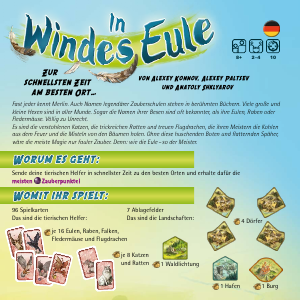
2
NINE is nothing special.
But TEN is awesome.
From ELEVEN on,
however,
it‘s
getting really crummy…
Whenever you are able to play a card that turns the
result in the middle of the table into TEN,
all laid-out cards are yours…
but it
must not be even a tiny bit more – otherwise,
only the rascal who had his turn
before you gets the pleasure of it.
The game in which everything revolves around 10.
For 2–
8 clever calculators,
6 years and up
by Ayelet Pnueli
Idea and Object of the Game
Whoever plays a card adds its value to the cards already laid out
– until TEN is reached or exceeded.
Whoever often reaches TEN
and has collected the most cards by the end of the game,
wins.
Game Materials and Set-up
Shuffle the cards thoroughly;
give each player three of them to take in his
hand.
Form a draw pile in the middle of the table from the remaining cards.
Special Cases:
The pigmaid (FIVE)
If you play a FIVE,
you may decide whether
you add or subtract this 5 to or from the
pile value.
However, the pile value may
never be less than zero.
Steve plays
a 5 and says
“five“.
Sally plays a 1,
increasing the pile
value to “six“.
Jane plays
a 5 and
says “one“.
Course of the Game
The player who can count to ten the fastest,
begins. You play clockwise in turn.
On your turn,
you play a card and then shout the pile value out loud.
In the next but one text box,
you find
how to calculate the new pile value.
Whoever reaches the pile value TEN shouts “PIG 10” and gets all the cards in the pile.
If
the pile value reached is higher than TEN,
his right neighbor wins the cards.
Lay down the cards you won in front of you.
After your turn,
you immediately draw another card from the draw pile,
so that you always have 3
cards in your hand.
This is how you calculate the pile value:
When playing a card into the empty middle of the table,
you state the number of this card
as the pile value.
Whoever has his turn after that,
simply adds the number of his card to
the previous value.
Steve goes
first. He plays
a 4 and says
“four“.
Sally plays a 3,
adds it to Steve‘s
4 and says
“seven“.
Jane plays
a 2 and says
“nine“.
Now Claudio plays a
6 and says “fifteen“.
Since this number
is higher than TEN,
Claudio‘s right
neighbor,
Jane, gets
all the cards in the
pile.
If Claudio had played a 1,
the pile
value would have been exactly TEN
and Claudio would have gotten all
the cards.
The last number to have been called is always the currently valid “pile value”.
The frog (ZERO)
If you play a frog (ZERO),
you say “ZERO“,
because the frog always sets the pile value
back to ZERO.
Steve plays a frog and
says “ZERO“.
Same card, same number
If you lay out the same card as the player before you or a card that equals the current pile
value,
you may either add the number on the laid-out card to the pile value (as usual) or
make the number on the card played the pile value.
Now Sally
also lays
out a 4 and
makes the
card value
“four“ the pile
value.
Now Claudio
plays an 8,
lea-
ving the pile value
at “eight“.
Now Jane plays a 4 too.
In doing so,
she could
leave the pile value at
the card value of
“four“,
but she decides to incre-
ase the pile value by 4 to
“eight“.
With a 4, Ste-
ve increases
the pile value
to “seven“.
Claudio lays
out a 3 and
says “three“.
End of the Game
When the draw pile has been used up, you go on playing your hand
cards until you have no more cards left.
The winner is the player
who has won the most cards.
© 2013 Zoch Verlag
Werkstraße 1
90765 Fürth
www.zoch-verlag.com
www.facebook.com / zochspiele
www.twitter.com / Zoch_Spiele
Author: Ayelet Pnueli
Illustration: Claudia Stöckl
English translation: Sybille & Bruce
Whitehill, “Word for Wort”
Art.Nr.: 60 110 05052












Praat mee over dit product
Laat hier weten wat jij vindt van de Zoch Pig 10. Als je een vraag hebt, lees dan eerst zorgvuldig de handleiding door. Een handleiding aanvragen kan via ons contactformulier.